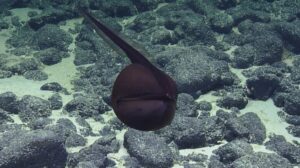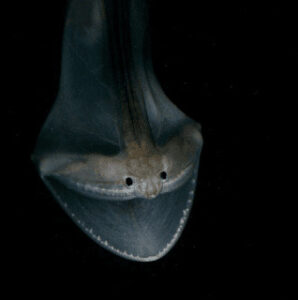Meet the Gulper Eel: The Deep-Sea Predator with an Unusual Appearance
The gulper eel, scientifically known as Eurypharynx pelecanoides, is an extraordinary creature inhabiting the depths of the sea. With its peculiar appearance and unique adaptations, it captivates the imagination of marine enthusiasts and scientists alike. Let us delve into the fascinating world of the gulper eel, exploring its physical attributes, feeding habits, reproductive behavior, and enigmatic life in the deep sea.

One of the most striking features of the gulper eel is its enormous mouth, which surpasses the size of its own body. This characteristic has earned it the nickname “pelican eel” due to the resemblance of its lower jaw to that of a pelican’s pouch. The mouth is loosely hinged, enabling it to open wide and accommodate prey much larger than the eel itself. Once the unfortunate victim is captured, it is deposited into a pouch-like structure within the lower jaw. This remarkable adaptation allows the gulper eel to consume sizable meals. In addition to its expandable stomach, the eel possesses a long, whip-like tail that serves as its primary means of movement. At the tail’s tip lies a light-producing organ called a photophore, which emits a pink glow and occasional red flashes through bioluminescence.
The gulper eel exhibits distinct physical characteristics that set it apart from other eel species. Unlike many deep-sea dwellers, it possesses small eyes that are likely specialized to detect faint traces of light rather than form detailed images. Its pectoral fins are incredibly minute, almost non-existent. The eel’s coloration usually ranges from black to dark green, occasionally featuring a white line or groove along either side of its dorsal fin. Some specimens brought to the surface in fishing nets have been discovered with their long tails intricately tied into knots, highlighting the eel’s extraordinary flexibility.

The feeding habits of the gulper eel primarily revolve around small crustaceans, such as shrimp and other small invertebrates. Due to its tiny teeth, it is unlikely to consume large fish on a regular basis. Nevertheless, the largemouth serves as an adaptation that enables the eel to expand its dietary options when resources are scarce. It can also function as a net, allowing the eel to swim into groups of shrimp or crustaceans and scoop them up effortlessly. Cephalopods, including squid, also form part of its diet. When the gulper eel engulfs its prey, it simultaneously takes in a significant amount of water, which is subsequently expelled through its gill slits.
Predators of the gulper eel include lancetfish and other deep-sea predators. While not much is known about its reproductive habits, researchers have observed notable differences between males and females. As males mature, their olfactory organs responsible for the sense of smell enlarge, while their teeth and jaws degenerate. This suggests that males may locate mates through pheromones released by females. Conversely, females undergo relatively fewer changes as they mature. It is speculated that gulper eels may experience a decline in health and lifespan after reproduction.

The gulper eel’s enigmatic existence in the depths of the sea poses significant challenges for researchers seeking to uncover its secrets. Our knowledge of this remarkable creature primarily stems from specimens inadvertently caught in deep-sea fishing nets. The gulper eel can be found in tropical and temperate oceans across the globe, dwelling at depths ranging from 500 to 6,000 feet (approximately 150 to 1,800 meters).
In conclusion, the gulper eel’s distinctive appearance and adaptations make it a captivating subject of study in the realm of marine biology. Its enormous mouth, expandable stomach, small eyes, and bioluminescent tail showcase the wonders of evolution and survival in the deep sea. While our understanding of the gulper eel is still limited, each discovery sheds light on its mysterious lifestyle. As researchers continue to explore the depths, we hope to uncover more about the hidden marvels of the gulper eel and the diverse ecosystem it inhabits.
